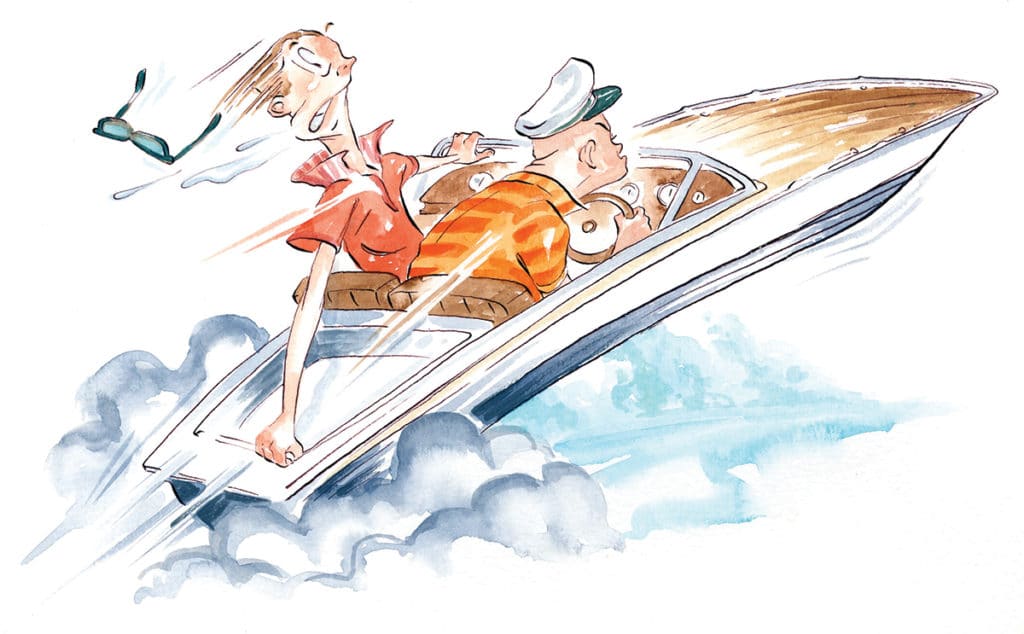
The fastest I’ve ever gone in a boat is 116 mph. I stood at the helm of a 42-foot Cigarette next to a veteran speed merchant named Bud Lorow. As he expertly worked the wheel and throttles, I turned to say something to him. The wind ripped my sunglasses off my head and pulled all the saliva out of my mouth. Thankfully nobody was standing directly behind me. During my turn at the wheel, I clocked 108 on the GPS before losing my nerve and slowing down. The two things I remember most vividly about that run are how the channel markers that seemed far apart at regular speed passed by in blindingly quick succession and how the slightest touch at the wheel made the boat move more dramatically than expected.
Driving a boat at high speed is just different. Most recreational boats have an open helm, so you can feel every bit of 50 mph (the boat-speed gold standard) on the water, while maintaining that speed in a car will get you honked at in the slow lane. But there’s more to it than that. Here are three important things to consider while driving your boat at wide-open throttle.
Connectivity
Unless you’re Bo and Luke Duke, you always have four tires connected to the asphalt while driving a car, no matter the speed. In a boat, the faster you push your vessel — especially with proper trim — the less of it is actually connected to the water. In extreme cases, as with a bass boat, only the prop and lower unit remain in the water at speed. In a typical planing deep-V, the aft one-third to one-fifth of the boat will remain in contact with the water. That means the boat is going to feel more responsive to minor adjustments at the helm yet under less control at the start of a turn. Be judicious while at the wheel because overcorrecting, turning too hard, or taking on waves at the wrong angle can have serious consequences.
Quick Tip: To keep your sunglasses on when boating at high speed, invest in a pair of sunglass straps that you can adjust to fit tightly. That way, they’ll stay on your head instead of flying off into the abyss.
Reaction Time
A few years ago, I spent time on the water with Mark Granet, driver of the famous Miss Geico race boat, which he’s pushed to speeds exceeding 200 mph. He mentioned then that when most regular boaters go fast, they aren’t used to the closure speeds that come with it — something I experienced firsthand when passing those channel markers in the Cigarette. Trying to quantify Granet’s statement, I calculated that a boat running at 50 mph is traveling 73.3 feet per second, or ¼ mile every 20 seconds. That means if you notice something in front of you, the boat will cover a lot of ground before you are able to react and respond. And boats, of course, don’t have brakes. Even if you kill the throttle, the boat is going to glide a certain distance before falling off plane. (Plus, because boats don’t have seatbelts, suddenly chopping the throttles back will throw your crew forward.)
Speed Bumps
A pilot I know who flew fighter jets for the Navy and jumbo jets for a commercial airliner scoffs at people who are afraid of turbulence. “It’s just little speed bumps,” he likes to say. “You only feel it because you’re hitting it at 500 mph.” I like to think of his words when I’m at the helm. The faster you go, the more impact you feel while running in waves or a rough chop. The corollary to that is most boats have a sweet spot where they ride on top of a light chop or tightly stacked waves, which can increase comfort for those on board. Sometimes this occurs at higher speeds. You can only figure out where that is with accumulated knowledge, which circles back to the best advice Granet, Lorow and other expert drivers have imparted: Before you try to go fast, spend a lot of time getting to know your boat.









